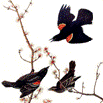Wildlife Damage Management, Internet Center for
Document Type
Article
Date of this Version
November 1979
Abstract
Each winter an estimated 350 million starlings, red-winged blackbirds (Agelaius phoeniceus), common grackles (Quiscalus quiscula), and brown-headed cowbirds (Molothrus ater) congregate in roosts in the southeastern United States (Meanley 1971, Meanley and Royall 1976). These birds have been of increasing concern because of agricultural damage claims (Stickley et al. 1976, Dolbeer et al. 1978), reputed health hazards (Monroe and Cronholm 1977), and other nuisance problems associated with them. Historical population trends (Dolbeer and Stehn 1979) and the source of winter-roosting blackbirds (Meanley 1971, Meanley and Dolbeer 1978, and Dolbeer 1978) have been summarized, but little information on the number of consecutive nights a bird returns to the same roost (roost fidelity) or the dynamics of a winter roost is available. The purpose of this paper is to present information on roost fidelity and population dynamics needed to better understand and manage winter blackbird and starling roosts.


